Save some serious cash when celebrating your nuptials with this simple, elegant DIY Wedding Cake. This two-tiered masterpiece is made with moist vanilla-almond cake and sumptuous buttercream frosting for a crowd-pleasing favorite and includes two cupcakes to freeze for your first anniversary.

If you've been wondering how to make a professional wedding cake at home, you've come to the right place! Don't get intimidated if you're a cake-decorating novice – using a semi-naked frosting technique, fresh flowers, and berries, this approachable design is easy enough for any home cook to tackle.
Jump to:
- Why You Should DIY Your Wedding Cake
- Ingredients & Substitutions
- Special Equipment
- How to Make Homemade Wedding Cake
- Tips & Tricks For A Stress-Free DIY Wedding Cake
- Flavor Variations
- Decorating Options
- Cake Decorating Tips
- Other Ideas To Keep Your Wedding Dessert On Budget
- Frequently Asked Questions
- Easy, Inexpensive DIY Wedding Cake
- Decorating Options
- 💬 Reviews
Why You Should DIY Your Wedding Cake
1.) It'll help you stay on budget.
Not to rain on your parade (er, wedding), but large celebrations are often quite expensive. If your budget is important to you, then the wedding industry as a whole is something you should try to avoid as much as possible! Seriously. Even breathing the word wedding seems to jack the prices of everything up even more than the pink tax.
With average wedding cakes costing around $500 (or $5-10 per slice), they're definitely a big ticket item. And with inflation at its highest since the 80s, these numbers are only likely to increase.
I know you might be thinking, "Isn't making your own cake a recipe for stress and disaster??" As someone who DIYed her own wedding cakes and homemade cookie wedding favors -- for 150 guests, no less! -- I can promise that the task is entirely doable, especially with the help of a friend or family member (or several).
Even with having to purchase some special equipment and ingredients, making your own wedding cake will save money for more important things, like a honeymoon or a house payment!
All in, this two-tiered masterpiece cost me about $63 to make, including purchasing two additional 6" pans and 6" cake rounds, as well as a bunch of berries that ended up on other pieces on the dessert table.
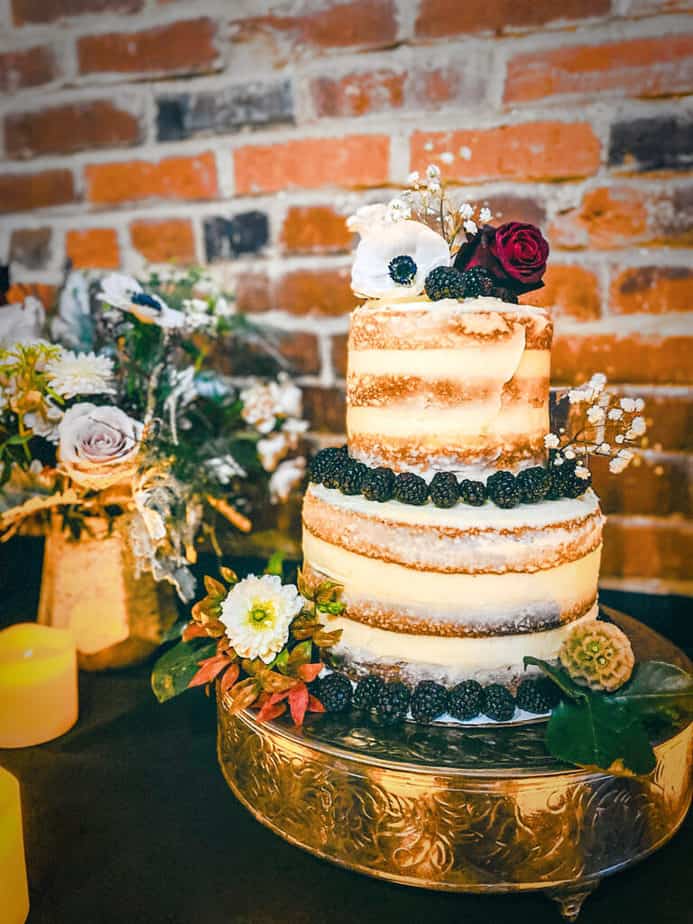
2.) It feels more personal
I'm someone who shows her love through food. Heck, when I was being "rebellious" in high school and parents would go out of town, my crew would play grown-up and host dinner party sleepovers. (Granted, there may or may not have been many bottles of 2 Buck Chuck, but still.)
I should add a disclaimer here: I am 100% on board with a rustic aesthetic. In fact, I vehemently despise fondant as an ingredient (it tastes like vaguely sweet rubber), and I hate the idea of inedible garnishes (yes, I always eat the parsley, thankyouverymuch).
So, the idea of an elaborately designed fondant wedding cake that is painted, prodded, and airbrushed to look like a [insert *literally anything* here] is in complete opposition to my cooking/food values. If that's the cake you have at your wedding and I'm lucky enough to be invited, I will happily enjoy it! It's just not for me.
3.) You have complete control
As a bride myself, I was relatively chill about wedding planning. Granted, my adoring Mom was heavily involved and made things way easier for Joe and I. (Thanks, Mom!)
That said, I'm still someone with a very strong opinion - especially about food. Sharing a beloved and familiar family recipe with loved ones was a no-brainer; I knew it'd taste delicious, and I trusted the recipe would work out well as it had so many times in the past.
If you have a favorite family cake recipe, it can easily be converted to make this tiered wedding cake! You'll just need to do a little math. Note that if you are making different types of cake for your layers, the sturdier cakes (e.g. pound cakes) should be used for the base layers, while the more delicate ones (e.g. sponge cakes) should be used for the top layers.
Ingredients & Substitutions
I went SUPER basic with this cake recipe to make sure it was accessible to everyone. These are all ingredients that you should be able to find at any store:
- All Purpose Flour - I adapted this recipe from Chelsweets's WASC (white almond sour cream) cake, which not only has incredible reviews, but also uses regular AP flour rather than a specialty product like cake flour.
- Granulated Sugar - Technically, you can swap in brown sugar if you like, but the cake will not be as snowy white as you might like.
- Baking Powder - Don't trade in baking soda, they react differently!
- Kosher Salt - I buy Morton's Kosher Salt in large quantities from Costco. If you are using a different kind of salt, check out this handy salt conversion guide. Also, word to the wise - don't use iodized table salt; the iodine imparts a bitter flavor that is pretty off-putting.
- Butter - I use regular ol' butter in my house because it not only tastes better, but also has a longer shelf life. Most baking gurus would suggest you opt for unsalted butter for baking, but I've always been a rebel - it hasn't bitten me in the butt thus far!
- Heavy Cream - Heavy cream has a milk-fat percentage of at least 36%, which lends a lovely mouthfeel to the buttercream. Feel free to swap in whipping cream instead (which has a milk-fat percentage of 30-36%), but don't try using low-fat or non-fat cream. This is a wedding - be decadent!
- Vanilla & Almond Extracts - The original recipe I based this off of was for a white almond sour cream cake. I *love* the flavor of almond (I almost always use half almond and half vanilla extract in recipes that just call for vanilla), but wanted more of a traditional vanilla cake vibe. Feel free to use only vanilla, or swap in another flavor like lemon extract if you prefer. NOTE: If you want a stark white cake and frosting, this is the one place I'll recommend reaching for artificial vanilla extract; pure vanilla extract will lend the slightest bit of color and make your frosting more of an ecru-white.
- Egg Whites - Feel free to make life easy and use liquid whites from a carton here. If you opt to separate whole eggs, try my recipe for Homemade Banana Pudding with Coffee Rum Fudge to use up those extra yolks.
- Sour Cream - You can also use full fat Greek yogurt if you prefer.
- Powdered Sugar - Also known as confectioner's sugar, this is an essential component of most frostings. If you don't have any on hand, make your own using granulated sugar and cornstarch!
- Vegetable Oil - Any neutral flavored oil will work here - avocado, grapeseed, canola, corn, or peanut oil will all do the trick.
Special Equipment
This DIY Wedding Cake is a big project, and it requires a few pieces of specialized equipment.

- Electric Mixer With Paddle Attachment - Now is not the time to mess around with mixing batter and frosting by hand. In total, you'll be making around 14 cups of cake batter and 6 cups of buttercream - that requires a LOT of power. Using a stand mixer is preferred, but you can make a hand mixer work in a pinch.
- 6" and 9" Round Cake Pans - For this recipe you'll need 3 of each size. Feel free to multiply the ingredients by .66 if you would rather use just 2 of each size. NOTE: If you still want more than 2 layers but are only baking 2 of each size, feel free to cut each cake hamburger-bun-style; this way you can have 4 layer cakes for each tier!
- Plastic Dowels - When you add tiers to a cake, you need to ensure structural integrity. Plastic dowels are inexpensive to buy and are easy to score and cut to the proper height.
- Bench Scraper - Bench scrapers are amazing for things like bread or pasta making; they can cut dough, scrape up flour from your work surface, and can also act as a frosting assistant when making cakes.
- Offset Spatula - If you have a bench scraper, you can probably get away without using an offset spatula. Use the back of a spoon to create any swirls or swoops in the frosting that you prefer. If you don't have a bench scraper, I highly recommend investing in an offset spatula.
- Cake Rounds - A round of cardboard that holds your cakes is essential, especially for stacking on tiers. If you prefer, you can DIY these - simply trace the bottom of your pans onto sturdy cardboard and cut them out using an Exacto knife. To ensure that the cake remains food safe, I recommend wrapping any homemade cake boards with foil or saran wrap.
- Cake Turntable - Using a cake turntable (or even the Lazy Susan from your pantry) makes cake decorating so much easier. If you don't have a turntable you can still make it work, but your frosting will likely not end up quite as uniform as if you had used one.
How to Make Homemade Wedding Cake
There are essentially 5 steps to making a DIY wedding cake: baking the cakes, making the frosting, frosting the cakes, layering the tiers, and then decorating the final cake. While that might seem like a lot, I promise - you've got this!
Also, remember that you can break these 5 steps up to reduce your stress leading up to the wedding! The cakes can be baked and frozen up to a month in advance, and the buttercream can be made and refrigerated up to a week in advance.

A Note About Using Two Recipes
In the recipe card below, I have created two separate recipes - one for the 6" cakes that will create the top tier, and one for the 9" cakes plus the two extra cupcakes for the bride and groom to freeze for their 1-year anniversary. If you're thinking to yourself "these have the same exact ingredients and steps, so I'm just going to combine them into one recipe to save time," STOP RIGHT THERE.
I implore you, work separately rather than trying to cut corners. Most home mixers won't be able to tackle all the cake batter at once. In fact, my 5-quart mixer was just barely able to eke out the larger recipe.
Baking separately also ensures that your cake layers don't get overdone. 6" cakes bake faster than 9" cakes, and if your oven is anything like mine, it tends to cool down a lot each time I open the door. Working as though the cakes are two separate recipes will help ensure that your cakes end up perfectly baked.
Make Cakes
As noted above, both cake recipes use the same ingredients and techniques. Either recipe can be made by following these instructions.

First, get your station prepped. You'll need to grease and line all of your cake pans with parchment. Preheat your oven to 350F.

Mix together the flour, sugar, baking powder, and salt in the bowl of your mixer.

With the mixer on low, slowly add pieces of softened butter to the dry mixture.

Continue mixing until all of the butter has been added and the consistency of the mixture looks like wet sand. There should be no large pieces of butter still evident in the mix. Make sure you scrape the sides and bottom of the bowl to incorporate everything well.

Add egg whites, mixing until just incorporated. Again, scrape the bottom and sides of the bowl to ensure an even mix.


Add sour cream, almond & vanilla extracts, and the oil. Mix until just combined. Scrape down the sides and bottom one more time, and give the mixture a final mix to incorporate.

Divide the batter evenly among the three pans. If you want to get super technical, use a kitchen scale to ensure even distribution between the pans, otherwise, just eyeball it. By my measurements, you should have about 800 grams of batter per 9" pan, 400 grams per 6" pan, and enough batter leftover for two cupcake liners to be filled about ⅔ full.
Bake in preheated oven until the cakes are fully baked and pass the toothpick test for doneness. 9" cakes should be done in 36-40 minutes, 6" cakes should be done in 31-34 minutes, and cupcakes should be done in 21-24 minutes.
Remove from the oven and allow to cool in their pans for about 10 minutes before inverting onto a cooling rack to finish cooling.
Make Buttercream
The amount of buttercream that this recipe produces is just enough to do a semi-naked frost on the two tiers, plus a little leftover to swoosh on the anniversary cupcakes. If you want to do more of a traditional, fully frosted look, make the recipe as written, then halve the recipe and make it again.
Note that you should work separately here if you're adding extra frosting. You're going to want plenty of this delicious frosting and don't want to wear out your equipment!

Beat the butter and salt on medium speed until it becomes light and fluffy, about 2-3 minutes.

Working in stages, add the powdered sugar to the butter with the mixer on low.
As you add more powdered sugar, the mixture will start to become thick and quite tight. When this happens, start alternating adding the cream and the powdered sugar until everything is well incorporated.

Add in the vanilla and almond extracts, mixing until fully incorporated and the frosting is the consistency you desire. NOTE: If your frosting is too thick even after mixing for several minutes, add more cream a tablespoon at a time until it loosens to your preferred consistency.
Assembly
You've made it this far, and now you're in the home stretch! Give yourself a pat on the back and take a deep breath. You've got this!
Frost Cakes

Use a dab of frosting to attach the bottom layer of the cake to the cardboard cake round.


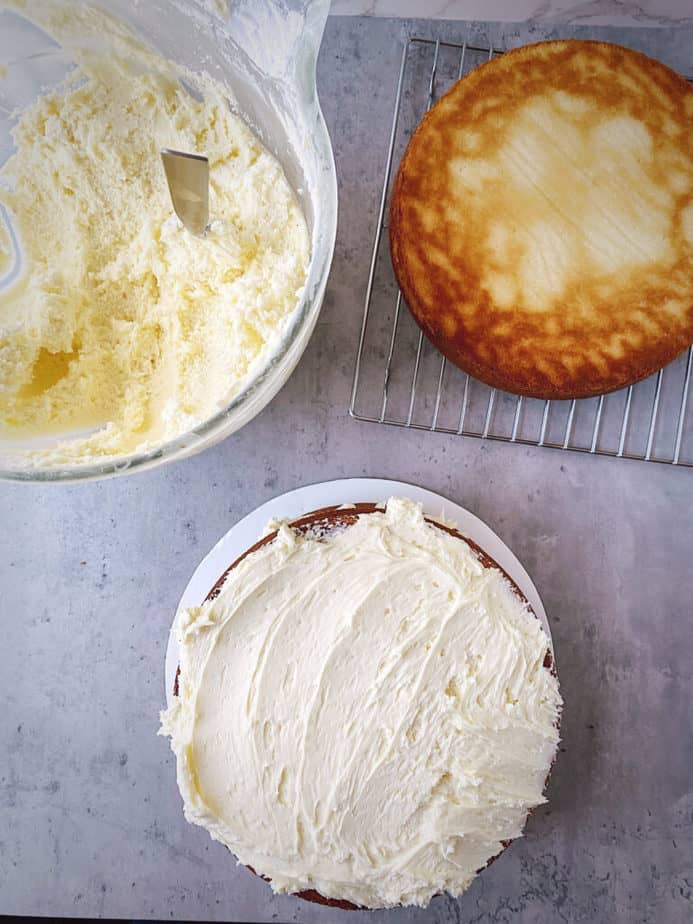

Add an even layer of frosting between each layer, spreading the frosting all the way to the edge.

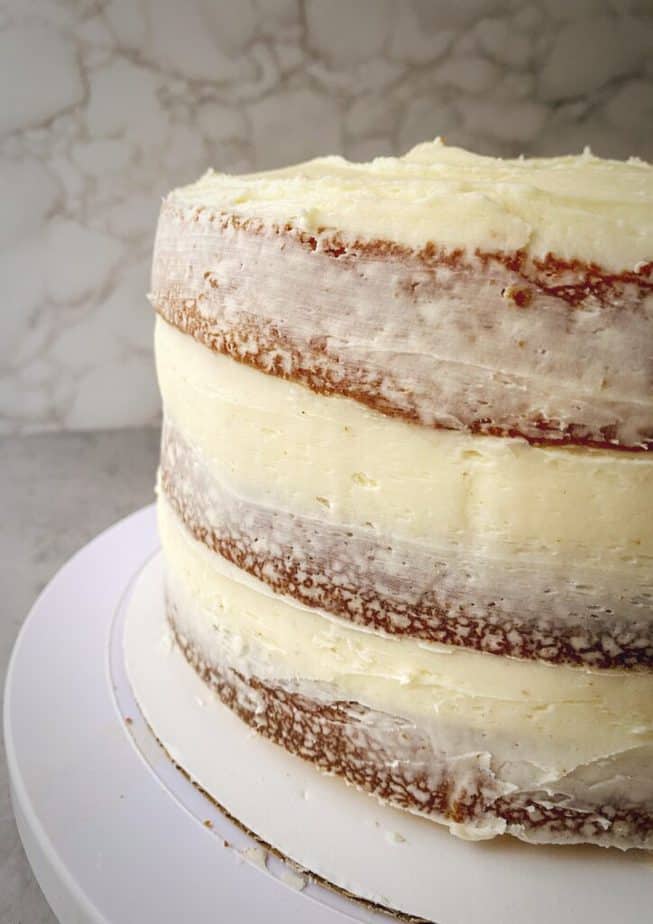
Apply a thin layer of frosting on the outside of the cake, using an offset spatula or bench scraper to smooth it out and scrape it to your desired level of nakedness. (NOTE: If you are going for a fully frosted look, follow this step and allow the frosting to set before continuing with a thicker frosting layer.)
Insert Dowels and Stack Tiers
Please note that in the following pictures, I had not yet frosted the top of the cake because I wanted to make sure you could see the dowels. Feel free to use this method and frost over the top of them, or feel free to frost all the way before inserting them.

Once the 9" cakes are frosted to your liking, hold up a plastic dowel to measure where it should be cut.
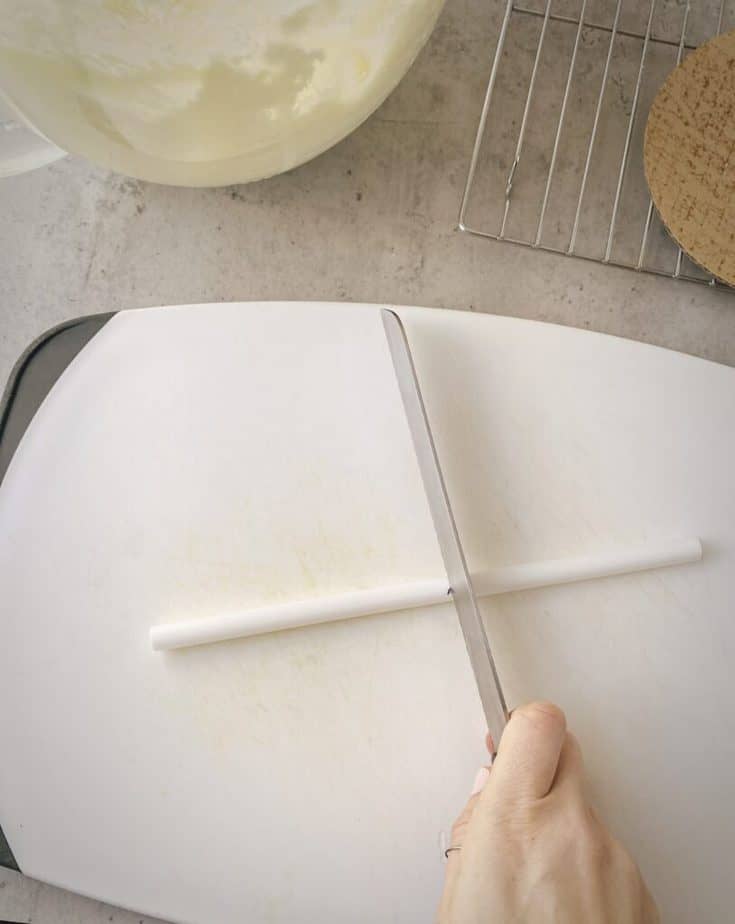
Using a serrated knife (or very strong scissors), cut the dowels to the correct size.


Place a 6" round or pan atop the cake in the middle of the top of the 9" cake, pressing down slightly to indent the frosting. This will act as your guide.
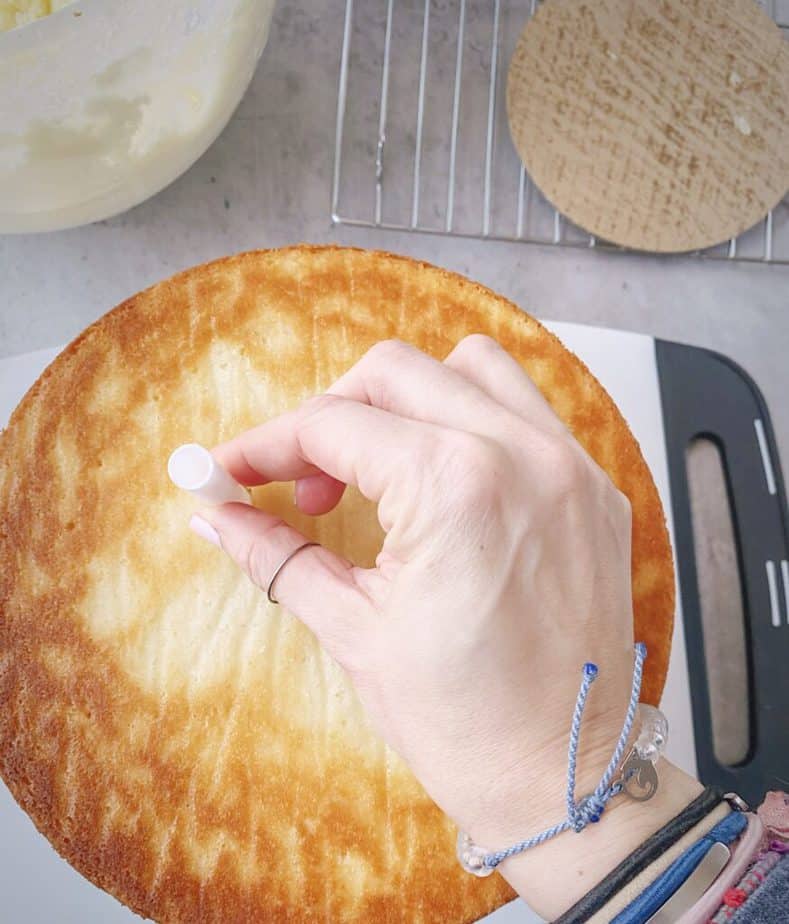

Spacing the dowels roughly 2" apart, press the dowels down into the cake within the 6" circle guide you just created. The dowels should be quite flush with the cake - if the first one is not, remove it, trim as needed, then proceed to trim the remaining dowels before proceeding.
NOTE: If you are going to need to transport the cake to a different venue, this is a good stopping place. Don't stack the tiers or do final decorating until you are at the venue!
Using an offset spatula for assistance with balancing, slowly and carefully set the 6" cake on top of the dowels. That wasn't so bad, right?!?
Decorate

Now you've arrived at the fun part. Use flowers, berries, and/or a cake topper to make your DIY wedding cake look super pro. For even more decorating ideas, pop down a few sections!
Tips & Tricks For A Stress-Free DIY Wedding Cake
- Work in stages. You can literally make the cake portion of your wedding cake up to a month in advance if you wrap and freeze it. The buttercream can also be made up to a week in advance and refrigerated. Just be sure to allow it to come to room temp and give it a quick whip before decorating the cake with it.
- Parchment! Yes, you're greasing the cake tins, but for added insurance, don't skip out on the parchment. Just trust me. I've lost many a pretty cake edges because I thought I could skip this step.
- KISS the design. Keep it simple, Sugar! The best part of a rustic wedding cake design is that you don't have to do a whole lot.
- Use dowels and cake rounds for stability. Don't try stacking a tiered cake without these essential tools.
- Enlist help. Chances are, at least one of your family members or friends who will be in attendance has a good aesthetic eye. If you're going to be busy getting gussied up for your big day, assign someone else the job of stacking and decorating the cake at the event venue.
- Or don't make your own DIY wedding cake if it's going to stress you out! I was definitely a chill bride, but the last week of prep was a LOT. There's no shame in saying "F*** it" to making a DIY wedding cake. Jump down a few sections for other options to keep your dessert table on budget.
Flavor Variations
- Most cake batters will do; you can even make a tiered cake using boxed cake mix! A good rule to keep in mind is that if it can be turned into a layer cake, it should do well as a 2-tier cake.
- Refer to cake conversion charts to determine how much batter to make. Also, be sure to work in batches so as not to overwhelm your mixer.
- Add curd, jam or berries between layers for added flavor.
- Stir in mini chocolate chips or chopped nuts for textural interest.
Decorating Options
When it comes to making a DIY wedding cake, I'd argue that the most stressful piece of the pie (er, cake?) is making sure it looks gorgeous. Check out the suggestions below, feeling free to mix and match your way to a real show-stopper.

Naked - This style requires only adding frosting between the layers of the cake, leaving the sides completely exposed. This is the easiest decorating option.
Semi-Naked - This style adds frosting between the layers of the cake as we did in the naked cake, then adds a bit of frosting on the exterior (like a crumb coat). I love this rustic look, even when it applies to brick houses!
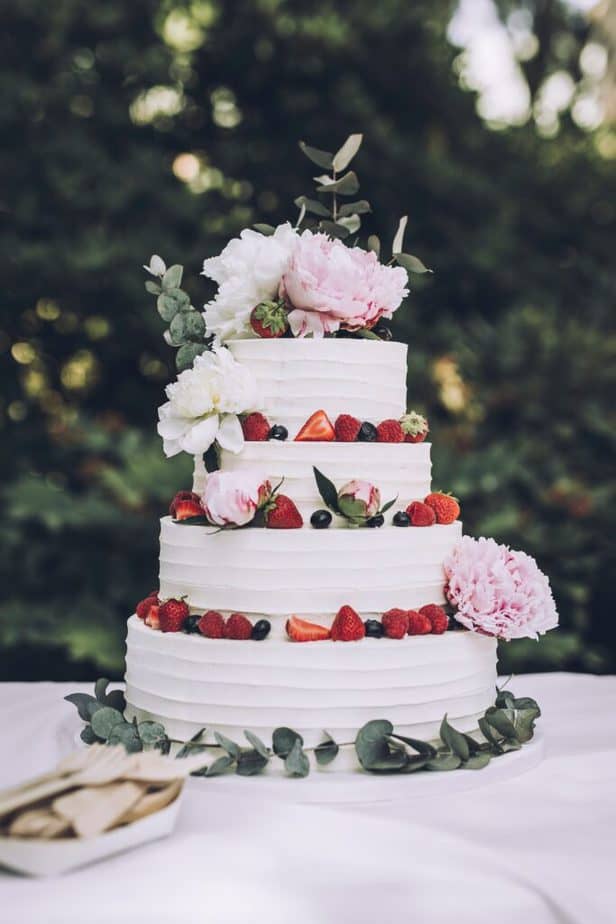
Fully Frosted - If you're all thumbs when it comes to cake decorating, don't go nuts with your piping. Easy frosting decorations include texturing like swoops, swirls, simple dots, or petals. You can also keep the exterior of the cake relatively flat and add visual interest using any of the options listed below. NOTE: You will need to make additional buttercream if you opt for a fully frosted cake. Please refer to instructions on making the frosting above.
Fresh Flowers - Keep the weight of your flowers (and gravity) in mind as you arrange them - don't let heavy blooms drape off the side, or they may end up tearing the cake. Also, be sure that your flowers aren't poisonous! You can also always opt to buy EDIBLE FLOWERS or sugar flowers if you are worried. If you are using fresh flowers, you'll also want to wash and dry them thoroughly before using. If you are using roses, try using this spinning technique to get them to open more before using them. For more tips on decorating with fresh flowers, check out this helpful post.
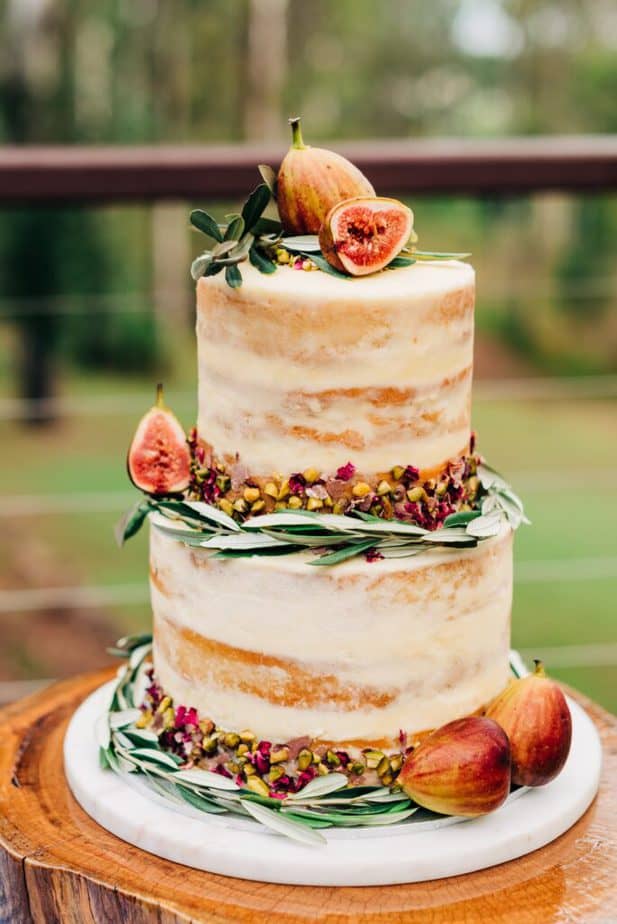
Fresh Berries & Fruit - While you're free to bust out your Morimoto-level knife skills to make strawberry roses, I find that an assortment of whole berries is simply stunning. If you're hosting a winter wedding, consider making sugared cranberries and rosemary.
Pineapple "Flowers" - As someone who prefers that all garnishes are edible, this Southern staple for decorating Hummingbird Cakes is one of my favorites. Note that these should not be made more than 2 days in advance, and they should be stored in an airtight container for best results.

Drips - Drip cakes are another one of my favorite cake aesthetics, and as a chocolate lover, the opportunity to add ganache to my cake is a no-brainer. This post from baking brand Wilton shows how you can easily make your drips fit in with your color scheme.
Sprinkles (a.k.a. Jimmies) - While there are lots of pretty options to keep things simple and white, feel free to play with your color theme here. Small sprinkles are easy to find, but larger pearl jimmies are another great option.
Cake Decorating Tips
- If you are baking the cake at a separate location than the wedding venue, you'll likely want to transport it as two separate layer cakes to prevent any traffic-related tragedies; slamming on the breaks is not conducive to your tiers staying in place! Nominate a friend or family member (or your catering crew) to complete the assembly and add any last-minute decor like berries or flowers.
- Bring extra frosting to the venue just in case. If you have a fully frosted cake, be sure you bring the frosting in a bag fitted with whatever tip you used to decorate.
- Cake rounds and plastic dowels are NON-NEGOTIABLE if you want a tiered cake. They are necessary for stability. Just trust me.
- Any frosting will work, but the most stable options include American Buttercream (like the one below), Swiss or Italian Meringue Buttercream, a hybrid Cream Cheese Buttercream, or Chocolate Ganache (feel free to use white chocolate if you prefer). If you are itching for whipped cream, just be sure to stabilize it and note that it should not be out of the cooler for long stretches of time.
- Also, keep the weather in mind - opting for a quick melting frosting isn't smart for an outdoor wedding in the summer.
- If you're fully frosting the cake or doing a semi-naked cake, splurge on a bench scraper. It's not just a one trick pony, either - bench scrapers can be super useful for dealing with sticky doughs; cutting lasagna, bar cookies or brownies; or even cleaning up your work surface after rolling out pie or pasta dough.
- Make your cake look extra large and fancy by adding in fake foam layers (this only works for fully frosted cakes).
Other Ideas To Keep Your Wedding Dessert On Budget
If you are considering making your own DIY wedding cake but aren't sure you're up to the task, you will receive exactly zero shade from this writer. There are plenty of other ways to DIY your dessert table without the stress of needing to both make and be the showstopper.

- Make a dessert bar! Have friends coordinate so you can have a variety of options, including cookies, cakes, pies, tarts, brownies, bars, donuts, or what have you. Hand written tent labels let your guests know which dessert is which. Also, cake stands are excellent for providing visual interest. Pro tip: cookie dough can be made, portioned and frozen weeks in advance. If you have a lot to bake off in a short period of time, get your friends in on it by giving them gallon sized ziplock bags of dough balls to bake off, or consider renting a commercial kitchen space for a few hours to knock out lots of batches all at once.
- Have a small "show" cake for cutting (no tiers necessary!), then opt for sheet cakes for guests. If you don't want the stress of making them yourself, Costco sells them for just $19 apiece.
- Consider buying a Costco, Sam's Club or Walmart cake and decorating it yourself with flowers and berries. In the same vein, rely on these big box retailers to help you fill out the rest of your dessert table with other options like macarons, chocolate chip cookies, fresh berries, or truffles.
- Opt for a candy bar. You can buy a bunch of different candy in bulk, put them in pretty vases, and leave out bags for guests to help themselves. This acts as both dessert and a parting gift!
Frequently Asked Questions
Oh hey, you planner! I see you. Feel free to bake off your cakes up to a month in advance. Wrap them *very* well in plastic wrap, then freeze. Allow to defrost on the countertop for about 45 minutes before decorating. Buttercream frosting can also be made and refrigerated up to a week in advance.
I recommend that you not frost the cake until the day before the wedding. Also, keep in mind that if you need to transport your cake, you'll probably want to keep the tiers separate until you get to the venue. This means you'll likely need to elect a friend or family member with a good eye to do any final decorations with flowers and berries.
Unless the poor thing is scorched to a crisp, you can still salvage it. First, trim off any bits that are too dark using a small serrated knife. If the area you're trimming is large, use a longer bread knife, and consider scraping the edge of the knife back and forth across the area rather than slicing.
Once the offending portion is removed, assess the situation. Does it feel dry? If so, consider making a simple syrup to brush on the layers. Simple syrup is equal parts water and sugar, boiled until the sugar dissolves. You can easily infuse the syrup with any number of flavors using ingredients like whole spices, fresh herbs, citrus or apple peels, even tea bags.
Once you've made the simple syrup, brush it on with a pastry brush or squirt it with a squeeze bottle. Now you should be ready to frost and assemble!
My friends, THIS is the beauty of the whole handmade, rustic aesthetic. There's no frosting sin so grave that flowers and berries can't hide, or scraping to a semi-naked finish won't fix.
Also, remember you're probably being a harsher critic than anyone - take a step away for a minute to get a breath of fresh air and a cup of tea. By the time you walk back, I bet you'll find it more charming than you remember.
Finally, remember that at the end of the day, the cake isn't what matters. It's the union of two people and their families. If the wedding ends with the bride and groom happily hitched, that's really all that counts.

If you try making this Easy, Inexpensive DIY Wedding Cake, please be sure to rate and review it below. And if you snap a pic of your gorgeous creations, be sure to tag me on Instagram so I can be blown away by your awesomeness!
You can also check out this great piece by my friends over at Porch.com for more ways to DIY your way to a gorgeous backyard wedding.

Easy, Inexpensive DIY Wedding Cake
Equipment
- 9" Round Pan x 3
- 6" Round Pan x 3
- Cake Dowels
- Cake Rounds
Ingredients
9" Cake + 2 Cupcakes
- 4 Cups AP Flour 520 grams
- 4 Cups Sugar 800 grams
- 3 ½ teaspoon Baking Powder
- 1 ¾ teaspoon Kosher Salt
- 2 ⅔ stick Butter room temperature
- 2 teaspoon Vanilla Extract
- 2 tsp Almond Extract
- 1 ⅓ Cups Egg Whites room temperature, from a carton is fine!
- 2 Cups Sour Cream room temperature, or full-fat greek yogurt
- 2 ½ tablespoon Vegetable Oil any neutral-flavored oil will work
6" Cake
- 2 Cups AP Flour 260 grams
- 2 Cups Sugar 400 grams
- 1 ¾ teaspoon Baking Powder
- scant 1 teaspoon Kosher Salt
- 1 ⅓ sticks Butter room temperature
- 1 teaspoon Vanilla Extract
- 1 tsp Almond Extract
- ⅔ Cup Egg Whites room temperature, from a carton is fine!
- 1 Cup Sour Cream room temperature, or full-fat greek yogurt
- 1 ¼ tablespoon Vegetable Oil any neutral-flavored oil will do
Buttercream Frosting (increase by 50% for fully frosted cake)
- 3 Cups Butter room temperature
- 11 Cups Powdered Sugar
- 2 teaspoon Kosher Salt
- ⅓ Cup + 2 Tablespoons Heavy Cream room temperature
- 1 tablespoon Vanilla Extract
- 1 teaspoon Almond Extract
Instructions
Make 9" Cakes + Cupcakes, and 6" Cakes separately
- First, get your station prepped. You'll need to grease and line all of your cake pans with parchment. Preheat your oven to 350F.Mix together the flour, sugar, baking powder, and salt in the bowl of your mixer. With the mixer on low, slowly add pieces of softened butter to the dry mixture. Continue mixing until all of the butter has been added and the consistency of the mixture looks like wet sand. There should be no large pieces of butter still evident in the mix. Make sure you scrape the sides and bottom of the bowl to incorporate everything well.Add egg whites, mixing until just incorporated. Again, scrape the bottom and sides of the bowl to ensure an even mix.Add sour cream, almond & vanilla extracts, and the oil. Mix until just combined. Scrape down the sides and bottom one more time, and give the mixture a final mix to incorporate.Divide the batter evenly among the three pans. If you want to get super technical, use a kitchen scale to ensure even distribution between the pans, otherwise, just eyeball it. By my measurements, you should have about 800 grams of batter per 9" pan, 400 grams per 6" pan, and enough batter leftover for two cupcake liners to be filled about ⅔ full.Bake in preheated oven until the cakes are fully baked and pass the toothpick test for doneness. 9" cakes should be done in 36-40 minutes, 6" cakes should be done in 31-34 minutes, and cupcakes should be done in 21-24 minutes.Remove from the oven and allow to cool in their pans for about 10 minutes before inverting onto a cooling rack to finish cooling.Repeat process for next-sized cakes.Make-Ahead Tip: Cakes can be made, wrapped thoroughly in plastic wrap and frozen for up to a month.
Make Buttercream
- Beat the butter and salt on medium speed until it becomes light and fluffy, about 2-3 minutes. Working in stages, add the powdered sugar to the butter with the mixer on low. As you add more powdered sugar, the mixture will start to become thick and quite tight. When this happens, start alternating adding the cream and the powdered sugar until everything is well incorporated.Add in the vanilla and almond extracts, mixing until fully incorporated and the frosting is the consistency you desire. NOTE: If your frosting is too thick even after mixing for several minutes, add more cream a tablespoon at a time until it loosens to your preferred consistency.Make-Ahead Tip: Frosting can be made and refrigerated up to a week in advance. Allow it to come to room temperature and give it a quick whip before frosting your cooled cakes.
Frost Cakes
- Use a dab of frosting to attach the bottom layer of the cake to the cardboard cake round. Add an even layer of frosting between each layer, spreading the frosting all the way to the edge.Apply a thin layer of frosting on the outside of the cake, using an offset spatula or bench scraper to smooth it out and scrape it to your desired level of nakedness. (NOTE: If you are going for a fully frosted look, follow this step and allow the frosting to set before continuing with a thicker frosting layer.)
Insert Dowels and Stack Tiers
- Once the 9" cakes are frosted to your liking, hold up a plastic dowel to measure where it should be cut. Using a serrated knife (or very strong scissors), cut the dowels to the correct size.Place a 6" round or pan atop the cake in the middle of the top of the 9" cake, pressing down slightly to indent the frosting. This will act as your guide.Spacing the dowels roughly 2" apart, press the dowels down into the cake within the 6" circle guide you just created. The dowels should be quite flush with the cake - if the first one is not, remove it, trim as needed, then proceed to trim the remaining dowels before proceeding.NOTE: If you are going to need to transport the cake to a different venue, this is a good stopping place. Don't stack the tiers or do final decorating until you are at the venue!Using an offset spatula for assistance with balancing, slowly and carefully set the 6" cake on top of the dowels.
Decorate Cake
- Now you've arrived at the fun part. Use flowers, berries, and/or a cake topper to make your DIY wedding cake look super pro. For even more decorating ideas, pop down to the notes section.
Notes
- This frosting is enough for a semi-naked 2-tiered cake. The amount of buttercream that this recipe produces is just enough to do a semi-naked frost on the two tiers, plus a little leftover to swoosh on the anniversary cupcakes. If you want to do more of a traditional, fully frosted look, make the recipe as written, then halve the recipe and make it again. Note that you should work separately here if you're adding extra frosting. You're going to want plenty of this delicious frosting and don't want to wear out your equipment!
- What should I do if my cake got over-baked? Unless the poor thing is scorched to a crisp, you can still salvage it. First, trim off any bits that are too dark using a small serrated knife. If the area you're trimming is large, use a longer bread knife, and consider scraping the edge of the knife back and forth across the area rather than slicing.
Once the offending portion is removed, assess the situation. Does it feel dry? If so, consider making a simple syrup to brush on the layers. Simple syrup is equal parts water and sugar, boiled until the sugar dissolves. You can easily infuse the syrup with any number of flavors using ingredients like whole spices, fresh herbs, citrus or apple peels, even tea bags.
Once you've made the simple syrup, brush it on with a pastry brush or squirt it with a squeeze bottle. Now you should be ready to frost and assemble!Decorating Options
When it comes to making a DIY wedding cake, I'd argue that the most stressful piece of the pie (er, cake?) is making sure it looks gorgeous. Check out the suggestions below, feeling free to mix and match your way to a real show-stopper. Naked - This style requires only adding frosting between the layers of the cake, leaving the sides completely exposed. This is the easiest decorating option. Semi-Naked - This style adds frosting between the layers of the cake as we did in the naked cake, then adds a bit of frosting on the exterior (like a crumb coat). I love this rustic look, even when it applies to brick houses! Fully Frosted - If you're all thumbs when it comes to cake decorating, don't go nuts with your piping. Easy frosting decorations include texturing like swoops, swirls, simple dots, or petals. You can also keep the exterior of the cake relatively flat and add visual interest using any of the options listed below. NOTE: You will need to make additional buttercream if you opt for a fully frosted cake. Please refer to instructions on making the frosting above. Fresh Flowers - Keep the weight of your flowers (and gravity) in mind as you arrange them - don't let heavy blooms drape off the side, or they may end up tearing the cake. Also, be sure that your flowers aren't poisonous! You can also always opt to buy EDIBLE FLOWERS or sugar flowers if you are worried. If you are using fresh flowers, you'll also want to wash and dry them thoroughly before using. If you are using roses, try using this spinning technique to get them to open more before using them. For more tips on decorating with fresh flowers, check out this helpful post. Fresh Berries - While you're free to bust out your Morimoto-level knife skills to make strawberry roses, I find that an assortment of whole berries is simply stunning. If you're hosting a winter wedding, consider making sugared cranberries and rosemary. Pineapple "Flowers" - As someone who prefers that all garnishes are edible, this Southern staple for decorating Hummingbird Cakes is one of my favorites. Note that these should not be made more than 2 days in advance, and they should be stored in an airtight container for best results. Drips - Drip cakes are another one of my favorite cake aesthetics, and as a chocolate lover, the opportunity to add ganache to my cake is a no-brainer. This post from baking brand Wilton shows how you can easily make your drips fit in with your color scheme. Sprinkles (a.k.a. Jimmies) - While there are lots of pretty options to keep things simple and white, feel free to play with your color theme here. Small sprinkles are easy to find, but larger pearl jimmies are another great option.





Kay says
Made this for my son’s wedding, huge success. My only change was swapping lemon for almond extract, as they are not almond fans. Excellent directions.
Ash, The Grocery Addict says
Congratulations, Kay! Marrying your sweet boy off AND tackling a homemade wedding cake?? So impressive! Thanks so much for sharing the fun flavor swap idea, too!